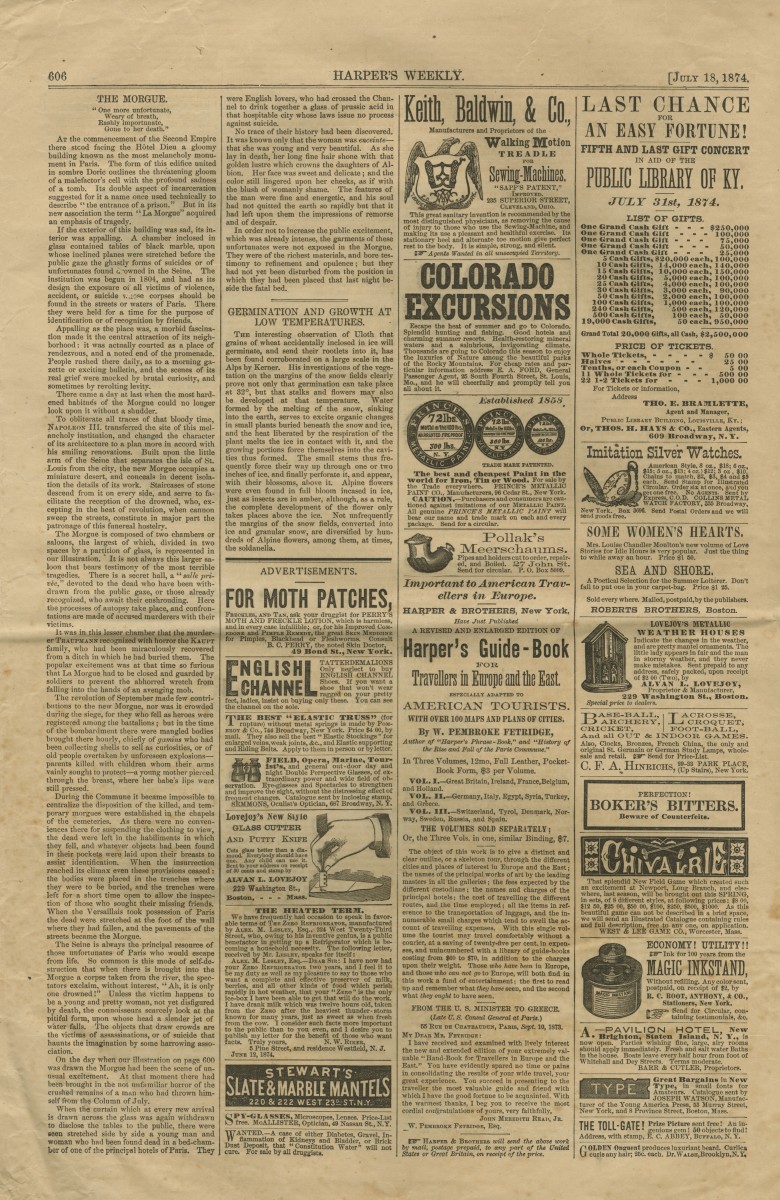-
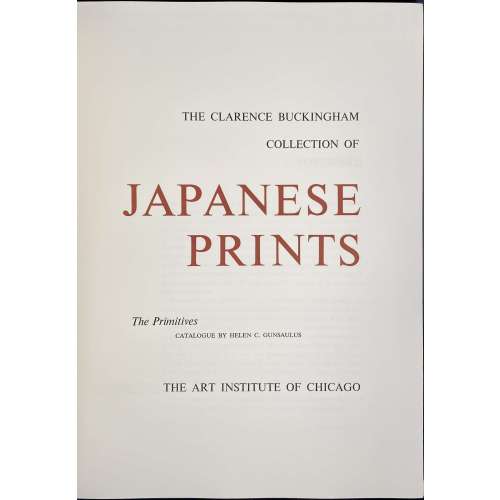 Two volumes, each bound in red cloth with gilt lettering to spine, black endpapers, TEG, and matching red cloth slipcases with black lettering to front. Vol. 1: The Clarence Buckingham collection of Japanese prints: The Primitives / Catalogue by Helen C. Gunsaulus. — [Chicago]: Art Institute of Chicago, 1955. Pagination: 1st leaf blank, 2nd leaf half-title, verso blank, [i, ii] – t.p. in red and black, copyright to verso, iii-vi, [vii] faux-title “The catalogue”, 1-284 [285] colophon, limitation: 500 numbered copies, this is № 476. Title-page: THE CLARENCE BUCKINGHAM | COLLECTION OF | JAPANESE PRINTS | The Primitives | CATALOGUE BY HELEN C. GUNSAULUS | THE ART INSTITUTE OF CHICAGO || Vol. 2: The Clarence Buckingham collection of Japanese prints: Volume 2 / Catalogue by Margaret O. Gentles. — [Chicago]: Art Institute of Chicago, 1965. Pagination: 1st leaf blank, 2nd leaf half-title, verso blank, [i, ii] – t.p. in red and black, copyright to verso, iii-vi, [vii] faux-title “The catalogue”,1-307 [2] blank/ colophon, limitation: 1000 copies (unnumbered). Title-page: VOLUME II | THE CLARENCE BUCKINGHAM | COLLECTION OF | JAPANESE PRINTS | Harunobu, Koryūsai, Shigemasa, their followers and contemporaries | Catalogue by Margaret O. Gentles | THE ART INSTITUTE OF CHICAGO 1965 || Contributors: Clarence Buckingham (American, 1854 – 1913) Helen C. Gunsaulus (American, 1886 – 1954) Margaret O. Gentles (American, 1905 – 1969)
Two volumes, each bound in red cloth with gilt lettering to spine, black endpapers, TEG, and matching red cloth slipcases with black lettering to front. Vol. 1: The Clarence Buckingham collection of Japanese prints: The Primitives / Catalogue by Helen C. Gunsaulus. — [Chicago]: Art Institute of Chicago, 1955. Pagination: 1st leaf blank, 2nd leaf half-title, verso blank, [i, ii] – t.p. in red and black, copyright to verso, iii-vi, [vii] faux-title “The catalogue”, 1-284 [285] colophon, limitation: 500 numbered copies, this is № 476. Title-page: THE CLARENCE BUCKINGHAM | COLLECTION OF | JAPANESE PRINTS | The Primitives | CATALOGUE BY HELEN C. GUNSAULUS | THE ART INSTITUTE OF CHICAGO || Vol. 2: The Clarence Buckingham collection of Japanese prints: Volume 2 / Catalogue by Margaret O. Gentles. — [Chicago]: Art Institute of Chicago, 1965. Pagination: 1st leaf blank, 2nd leaf half-title, verso blank, [i, ii] – t.p. in red and black, copyright to verso, iii-vi, [vii] faux-title “The catalogue”,1-307 [2] blank/ colophon, limitation: 1000 copies (unnumbered). Title-page: VOLUME II | THE CLARENCE BUCKINGHAM | COLLECTION OF | JAPANESE PRINTS | Harunobu, Koryūsai, Shigemasa, their followers and contemporaries | Catalogue by Margaret O. Gentles | THE ART INSTITUTE OF CHICAGO 1965 || Contributors: Clarence Buckingham (American, 1854 – 1913) Helen C. Gunsaulus (American, 1886 – 1954) Margaret O. Gentles (American, 1905 – 1969) -
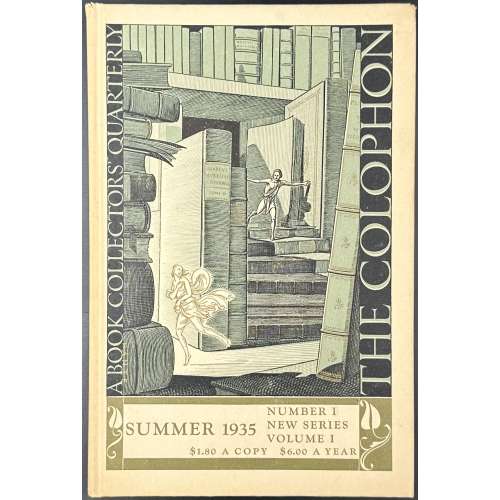
The Colophon, A Book Collectors' Quarterly
- The colophon (new series): A quarterly for bookmen / Summer 1935, № 1, vol. 1. — NY: Pynson Printers, 1935. Hardcover, 24 x 16 cm, paper boards, serial pictorial design; pp: [4 blanks] [6] 7-159 [160] [4 blanks]. THE | COLOPHON | new series | A QUARTERLY FOR BOOKMEN | {woodcut vignette} | — | SUMMER 1935 | VOLUME I • NEW SERIES • NUMBER 1 | NEW YORK, N. Y. ||
- The colophon (new series): A quarterly for bookmen / Autumn 1935, № 2, vol. 1. — NY: Pynson Printers, 1935. (2 copies). Hardcover, 24 x 16 cm, paper boards, serial pictorial design; pp: [4 blanks] [6] 167-315 [315] [4 blanks]. THE | COLOPHON | new series | A QUARTERLY FOR BOOKMEN | {woodcut vignette} | — | AUTUMN 1935 | VOLUME I • NEW SERIES • NUMBER 2 | NEW YORK ||
- The colophon (new series): A quarterly for bookmen / Autumn 1936, № 1, vol. 2. — NY: Pynson Printers, 1936. Hardcover, 24 x 16 cm, cloth serial design; pp: [4 blanks] [6] 7-157 [158] [4 blanks]. THE | COLOPHON | new series | A QUARTERLY FOR BOOKMEN | {woodcut vignette} | — | AUTUMN 1936 | VOLUME II • NEW SERIES • NUMBER 1 | NEW YORK ||
- The colophon (new series): A quarterly for bookmen / Winter 1936, № 3, vol. 1. — NY: Pynson Printers, 1936. (2 copies) Hardcover, 24 x 16 cm, paper boards, serial pictorial design; pp: [4 blanks] [6] 323-480 [4 blanks]. THE | COLOPHON | new series | A QUARTERLY FOR BOOKMEN | {woodcut vignette} | — | WINTER 1936 | VOLUME I • NEW SERIES • NUMBER 3 | NEW YORK ||
- The colophon (new series): A quarterly for bookmen / Autumn 1937, № 4, vol. 2. — NY: Pynson Printers, 1937. Hardcover, 24 x 16 cm, cloth serial design; pp: [4 blanks] [6] 487-628 [4 blanks]. THE | COLOPHON | new series | A QUARTERLY FOR BOOKMEN | {woodcut vignette} | — | AUTUMN 1937 | VOLUME II • NEW SERIES • NUMBER 4 | NEW YORK ||
- The colophon (new series): A quarterly for bookmen / Summer 1938, № 3, vol. 3. — NY: Pynson Printers, 1938. Hardcover, 24 x 16 cm, cloth new serial design; pp: [4 blanks] [6] 335-476 [4 blanks]. THE | COLOPHON | new series | A QUARTERLY FOR BOOKMEN | {woodcut vignette} | — | SUMMER 1938 | VOLUME III • NEW SERIES • NUMBER 3 | NEW YORK ||
- The colophon (new series): A quarterly for bookmen / Autumn 1938, № 4, vol. 3. — NY: Pynson Printers, 1938. Hardcover, 24 x 16 cm, cloth new serial design; pp: [4 blanks] [6] 483-632 [4 blanks]. THE | COLOPHON | new series | A QUARTERLY FOR BOOKMEN | {woodcut vignette} | — | AUTUMN 1938 | VOLUME III • NEW SERIES • NUMBER 4 | NEW YORK ||
-
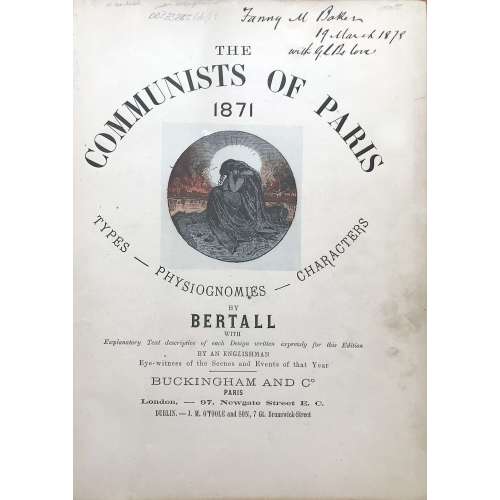 Folio (246 x 321 mm), hardbound in red-brown cloth with gilt lettering and decoration. Content, Introduction by J. E., September, 1873, Artist preface by Bertall, Paris, 1871-1873. Album with 40 hand-colored lithographs by Bertall, numbered 1 through 40, accompanied with extensive descriptions. Ex Libris: Baker. Carpe Diem. Markings: Janny M. Baker with J.L.B. Love, 19 March, 1878 in black ink.
Folio (246 x 321 mm), hardbound in red-brown cloth with gilt lettering and decoration. Content, Introduction by J. E., September, 1873, Artist preface by Bertall, Paris, 1871-1873. Album with 40 hand-colored lithographs by Bertall, numbered 1 through 40, accompanied with extensive descriptions. Ex Libris: Baker. Carpe Diem. Markings: Janny M. Baker with J.L.B. Love, 19 March, 1878 in black ink. -
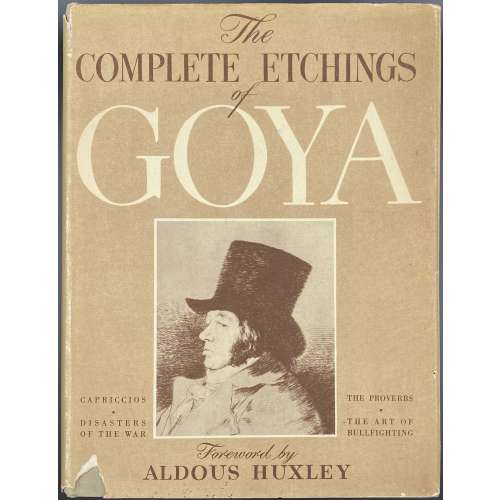 Title: THE COMPLETE ETCHINGS OF | Goya | With a Foreword by Aldous Huxley | CROWN PUBLISHERS. NEW YORK|| Pagination: [2 blank] [1-6] 7-16 [6], 234 plates on 118 leaves [2 blank] Contents: The capriccios [Los caprichos]. The disasters of the war [Los desastres de la guerra]. The art of bullfighting [La Tauromaquia]. The proverbs [Los disparates, Proverbios]. Miscellany. Binding: Hardcover, grey cloth, black lettering to cover and spine, pictorial DJ.
Title: THE COMPLETE ETCHINGS OF | Goya | With a Foreword by Aldous Huxley | CROWN PUBLISHERS. NEW YORK|| Pagination: [2 blank] [1-6] 7-16 [6], 234 plates on 118 leaves [2 blank] Contents: The capriccios [Los caprichos]. The disasters of the war [Los desastres de la guerra]. The art of bullfighting [La Tauromaquia]. The proverbs [Los disparates, Proverbios]. Miscellany. Binding: Hardcover, grey cloth, black lettering to cover and spine, pictorial DJ. -
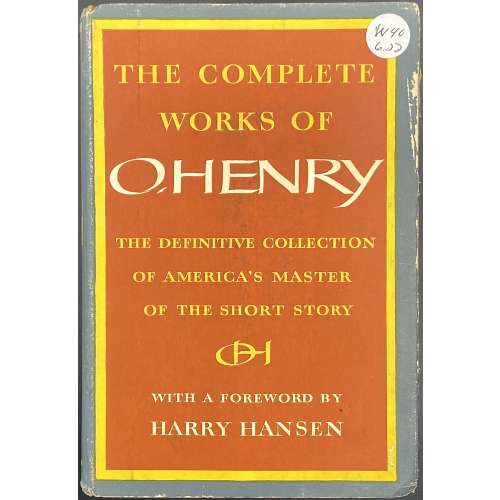 Two hardcover volumes, 22 x 15 cm each, uniformly bound in quarter orange cloth over blue cloth, red and blue lettering to spine, in a dust jacket lettered in yellow and white over red THE COMPLETE | WORKS OF | O. HENRY | THE DEFINITIVE COLLECTION | OF AMERICA’S MASTER | OF THE SHORT STORY | { OH monogram} | WITH A FOREWORD BY | HARRY HANSEN || Title-page: THE COMPLETE WORKS OF O. HENRY | FOREWORD BY HARRY HANSEN | VOLUME I (II) | 1953 | DOUBLEDAY & COMPANY, INC. GARDEN CITY, NY || Vol. 1: ffl, [i-v] vi-xiii [xiv] [2] [1] 2-810, ffl. Vol. 2: ffl, [i-v] vi-viii [2] [811] 812-1692, ffl. Contributors: O. Henry [William Sydney Porter] (American, 1862 – 1910) – author. Harry Hansen (American, 1884 – 1977) – author/foreword.
Two hardcover volumes, 22 x 15 cm each, uniformly bound in quarter orange cloth over blue cloth, red and blue lettering to spine, in a dust jacket lettered in yellow and white over red THE COMPLETE | WORKS OF | O. HENRY | THE DEFINITIVE COLLECTION | OF AMERICA’S MASTER | OF THE SHORT STORY | { OH monogram} | WITH A FOREWORD BY | HARRY HANSEN || Title-page: THE COMPLETE WORKS OF O. HENRY | FOREWORD BY HARRY HANSEN | VOLUME I (II) | 1953 | DOUBLEDAY & COMPANY, INC. GARDEN CITY, NY || Vol. 1: ffl, [i-v] vi-xiii [xiv] [2] [1] 2-810, ffl. Vol. 2: ffl, [i-v] vi-viii [2] [811] 812-1692, ffl. Contributors: O. Henry [William Sydney Porter] (American, 1862 – 1910) – author. Harry Hansen (American, 1884 – 1977) – author/foreword. -
 Top: THE ENVIRONS OF PARIS. || Bottom centre: Published by Baldwin & Cradock, Paternoster Row, | Under the Superintendence of the Society for the Diffusion of Useful Knowledge. | March 1st. 1832. || Bottom right: J. & C. Walker sculpt. || Dimensions: Sheet: 34.7 x 40.5 cm; Image: 30 x 37 cm. Contributors: J & C Walker (British firm, fl. 1820 – 1895) Walker, John (British, 1787 – 1873) Walker, Alexander (British, 1797? – 1870) Walker, Charles (British, 1799? – 1872) Society for the Diffusion of Useful Knowledge (SDUK) (British firm, 1826 – 1846)
Top: THE ENVIRONS OF PARIS. || Bottom centre: Published by Baldwin & Cradock, Paternoster Row, | Under the Superintendence of the Society for the Diffusion of Useful Knowledge. | March 1st. 1832. || Bottom right: J. & C. Walker sculpt. || Dimensions: Sheet: 34.7 x 40.5 cm; Image: 30 x 37 cm. Contributors: J & C Walker (British firm, fl. 1820 – 1895) Walker, John (British, 1787 – 1873) Walker, Alexander (British, 1797? – 1870) Walker, Charles (British, 1799? – 1872) Society for the Diffusion of Useful Knowledge (SDUK) (British firm, 1826 – 1846) -
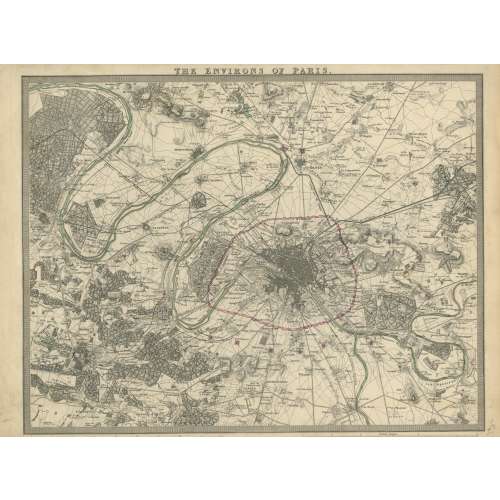 London: Published under the superintendence of the Society for the Diffusion of Useful Knowledge; Charles Knight & Co., no. 22 Ludgate Street. Dimensions: Sheet: 34 x 41.8 cm: Image: 28.7 x 38.3 cm. J. & C. Walker, Society for the Diffusion of Useful Knowledge Charles Knight & Co.; Charles Knight (British, 1791 – 1873) – publisher. J & C Walker (British firm, fl. 1820 – 1895) Walker, John (British, 1787 – 1873) Walker, Alexander (British, 1797? – 1870) Walker, Charles (British, 1799? – 1872) Society for the Diffusion of Useful Knowledge (SDUK) (British firm, 1826 – 1846)
London: Published under the superintendence of the Society for the Diffusion of Useful Knowledge; Charles Knight & Co., no. 22 Ludgate Street. Dimensions: Sheet: 34 x 41.8 cm: Image: 28.7 x 38.3 cm. J. & C. Walker, Society for the Diffusion of Useful Knowledge Charles Knight & Co.; Charles Knight (British, 1791 – 1873) – publisher. J & C Walker (British firm, fl. 1820 – 1895) Walker, John (British, 1787 – 1873) Walker, Alexander (British, 1797? – 1870) Walker, Charles (British, 1799? – 1872) Society for the Diffusion of Useful Knowledge (SDUK) (British firm, 1826 – 1846) -
![The erotic drawings of Mihály Zichy : Forty drawings. — New York: Grove Press Inc., 1969. — [2 intro.] + [40 ill.]](https://varshavskycollection.com/wp-content/uploads/2021/02/LIB-2244.2019-2-scaled-500x500.jpeg) Description: Oblong volume, 22 x 27 cm, quarter cloth over marbled boards with gilt Zichy’s signature fac-simile and gilt lettering to spine in dust jacket lettered “The | Erotic | Drawings | of | Mihály | Zichy” on both front and back, blurbs on flaps, unclipped; printed on wove paper, unpaginated. Title-page: THE EROTIC DRAWINGS | OF | MIHÁLY ZICHY | Forty drawings | GROVE PRESS INC. | NEW YORK || Collation: (1) h.t., (1) t.p./copyright, (1) Preface; (40) leaves of plates, (1) blank; total 44 leaves. The plates are photomechanical offset copies made from the photogravures of 1911 Leipzig private press edition [SVE-0501.2021] of 300 copies, the copy used for reprint was № 277; photogravures were made from the original watercolours and crayon drawings produced by Zichy in 1874-1879; the original album of 51 compositions was sold at Christie’s sale of Gérard Nordmann collection on December 14-15, 2006 in Paris. Ref.: Bibliothèque érotique: Gérard Nordmann; Livres, manuscrits, dessins, photographies du XVIe au XXe siècle / Catalogues de ventes, seconde partie. — Paris: Christie's, 2006; p. 280, № 564 (drawings); № 565 photogravures [LIB-2810.2021]. See a copy of the Leipzig album № 285 in this collection [SVE-0501.2021].
Description: Oblong volume, 22 x 27 cm, quarter cloth over marbled boards with gilt Zichy’s signature fac-simile and gilt lettering to spine in dust jacket lettered “The | Erotic | Drawings | of | Mihály | Zichy” on both front and back, blurbs on flaps, unclipped; printed on wove paper, unpaginated. Title-page: THE EROTIC DRAWINGS | OF | MIHÁLY ZICHY | Forty drawings | GROVE PRESS INC. | NEW YORK || Collation: (1) h.t., (1) t.p./copyright, (1) Preface; (40) leaves of plates, (1) blank; total 44 leaves. The plates are photomechanical offset copies made from the photogravures of 1911 Leipzig private press edition [SVE-0501.2021] of 300 copies, the copy used for reprint was № 277; photogravures were made from the original watercolours and crayon drawings produced by Zichy in 1874-1879; the original album of 51 compositions was sold at Christie’s sale of Gérard Nordmann collection on December 14-15, 2006 in Paris. Ref.: Bibliothèque érotique: Gérard Nordmann; Livres, manuscrits, dessins, photographies du XVIe au XXe siècle / Catalogues de ventes, seconde partie. — Paris: Christie's, 2006; p. 280, № 564 (drawings); № 565 photogravures [LIB-2810.2021]. See a copy of the Leipzig album № 285 in this collection [SVE-0501.2021]. -
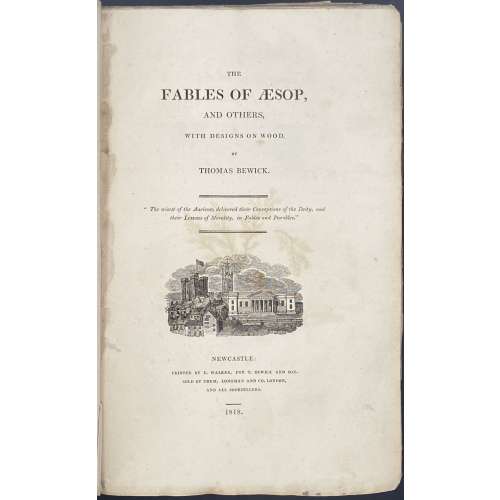 Title: THE | FABLES OF ÆSOP, | AND OTHERS, | WITH DESIGNS ON WOOD, | BY | THOMAS BEWICK. | “The wisest of the Ancients delivered their Conceptions of the Deity, and their Lessons of Morality, in Fables and Parables.” | {vignette} | NEWCASTLE: | PRINTED BY E. WALKER, FOR T. BEWICK AND SON. | SOLD BY THEM, LONGMAN AND CO. LONDON, AND ALL BOOKSELLERS. | 1818. || Pagination: [2] – blank / receipt with thumbprint, [i, ii] – t.p. / blank, [iii] iv-xvi – introduction with “Auld Clouty” vignette, [xvii] xviii-xxiv – table of contents, [1] 2-376; 188 wood-engraved head-pieces to the fables and 136 other vignettes, tail-pieces, etc. Collation: demy 8vo( octavo in fours); π1 (receipt), a-c4, B-3B4; A and 2P2 unsigned. Binding: Original blue boards, rebacked, original spine laid down, with original paper spine label ("Demy Paper/Price 15 s."); wove paper, top edge trimmed, the others are not; round book-plate to front paste-down “TWM, The Whitehead Library”; in a clamshell case, also book-plated inside. Size: case: 24.2 x 16.2 cm; boards: 22.8 x 14.2 cm; 22 x 14 cm. Note from seller: First copy in boards to ever appear at auction. Edition: First edition (one of 1,000 copies printed in demy 8vo), with Bewick's thumbprint and signature in facsimile, “Demy” and “15” in manuscript on receipt (page facing title-page), variant A (with "Auld Clouty" wood-engraving at bottom of p. XVI, and with the last line in p. 248 reading "road of honour and honesty"). "According to Roscoe, demy 8vo copies were apparently the first to be issued". There is 1 copy at the University Library, Cambridge and 1 at Liverpool public libraries. Catalogue raisonné: Roscoe: pp. 155-165, 45c for Variant A [see LIB-2714.2021]; Hugo (I vol.): p. 261; Ray: p. 35; Steedman: №№ 99-104, pp. 34-35 (№ 103 for Variant A).
Title: THE | FABLES OF ÆSOP, | AND OTHERS, | WITH DESIGNS ON WOOD, | BY | THOMAS BEWICK. | “The wisest of the Ancients delivered their Conceptions of the Deity, and their Lessons of Morality, in Fables and Parables.” | {vignette} | NEWCASTLE: | PRINTED BY E. WALKER, FOR T. BEWICK AND SON. | SOLD BY THEM, LONGMAN AND CO. LONDON, AND ALL BOOKSELLERS. | 1818. || Pagination: [2] – blank / receipt with thumbprint, [i, ii] – t.p. / blank, [iii] iv-xvi – introduction with “Auld Clouty” vignette, [xvii] xviii-xxiv – table of contents, [1] 2-376; 188 wood-engraved head-pieces to the fables and 136 other vignettes, tail-pieces, etc. Collation: demy 8vo( octavo in fours); π1 (receipt), a-c4, B-3B4; A and 2P2 unsigned. Binding: Original blue boards, rebacked, original spine laid down, with original paper spine label ("Demy Paper/Price 15 s."); wove paper, top edge trimmed, the others are not; round book-plate to front paste-down “TWM, The Whitehead Library”; in a clamshell case, also book-plated inside. Size: case: 24.2 x 16.2 cm; boards: 22.8 x 14.2 cm; 22 x 14 cm. Note from seller: First copy in boards to ever appear at auction. Edition: First edition (one of 1,000 copies printed in demy 8vo), with Bewick's thumbprint and signature in facsimile, “Demy” and “15” in manuscript on receipt (page facing title-page), variant A (with "Auld Clouty" wood-engraving at bottom of p. XVI, and with the last line in p. 248 reading "road of honour and honesty"). "According to Roscoe, demy 8vo copies were apparently the first to be issued". There is 1 copy at the University Library, Cambridge and 1 at Liverpool public libraries. Catalogue raisonné: Roscoe: pp. 155-165, 45c for Variant A [see LIB-2714.2021]; Hugo (I vol.): p. 261; Ray: p. 35; Steedman: №№ 99-104, pp. 34-35 (№ 103 for Variant A). -
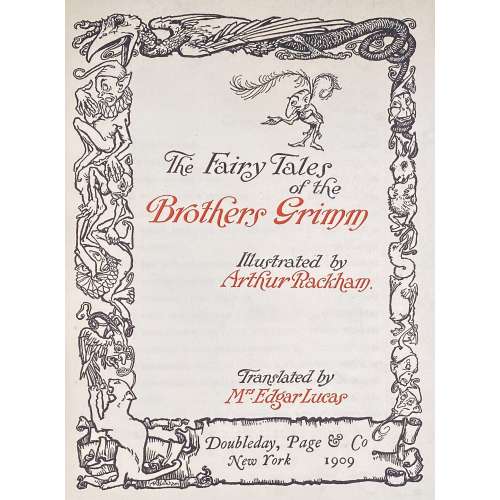 Title (black and red in pictorial frame): The Fairy Tales | of the | Brothers Grimm | Illustrated by Arthur Rackham. | Translated by | Mrs. Edgar Lucas | Doubleday, Page & Co | New York 1909. Pagination: [i-iv] – h.t., t.p., frontis., v-xv [xvi], 1-325 [326] colophon., [1 blank sheet], bfl; 40 tipped-in color plates (offset chromolithograph) with lettered guards, numerous in-text woodcuts. Collation: 4to; a-b4, A-2S4. Edition: 1st deluxe American large-paper edition, limited to 50 copies, Rackham’s facsimile signature to h.t. verso. Binding: Original full limp suede binding with yapp edges, gilt-ornamented and lettered spine. Top edge gilt, other uncut. Moiré endpapers. Printed on laid paper. Marbled endpapers.
Title (black and red in pictorial frame): The Fairy Tales | of the | Brothers Grimm | Illustrated by Arthur Rackham. | Translated by | Mrs. Edgar Lucas | Doubleday, Page & Co | New York 1909. Pagination: [i-iv] – h.t., t.p., frontis., v-xv [xvi], 1-325 [326] colophon., [1 blank sheet], bfl; 40 tipped-in color plates (offset chromolithograph) with lettered guards, numerous in-text woodcuts. Collation: 4to; a-b4, A-2S4. Edition: 1st deluxe American large-paper edition, limited to 50 copies, Rackham’s facsimile signature to h.t. verso. Binding: Original full limp suede binding with yapp edges, gilt-ornamented and lettered spine. Top edge gilt, other uncut. Moiré endpapers. Printed on laid paper. Marbled endpapers. -
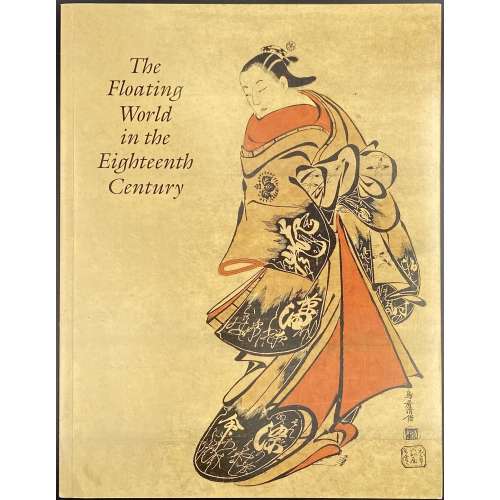 Softcover, in pictorial wrappers, 28 x 21.7 cm, 25 entries, with colour illustrations, some folding. Catalogue of the sales exhibition on March 28 -April 7, 2006, in NY; pagination: [2] 3-61 [62 blank [2], ils. Contributor: Sebastian Izzard
Softcover, in pictorial wrappers, 28 x 21.7 cm, 25 entries, with colour illustrations, some folding. Catalogue of the sales exhibition on March 28 -April 7, 2006, in NY; pagination: [2] 3-61 [62 blank [2], ils. Contributor: Sebastian Izzard -
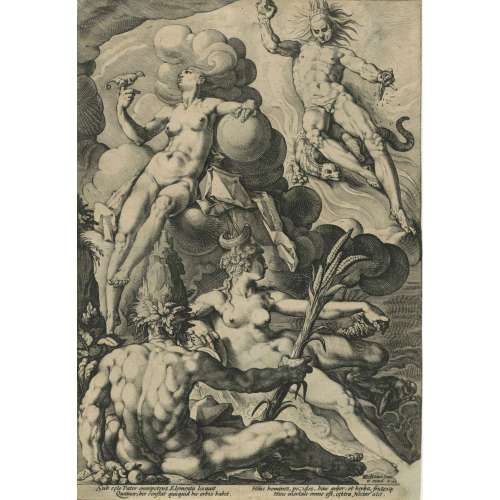
The Four Elements by Jacob Matham (Netherlandish, Haarlem 1571–1631 Haarlem) after Hendrick Goltzius (Netherlandish, Mühlbracht 1558–1617 Haarlem). Engraving on copper, printed on laid paper, 1588.
Dimensions: 298 mm × 206 mm.
-
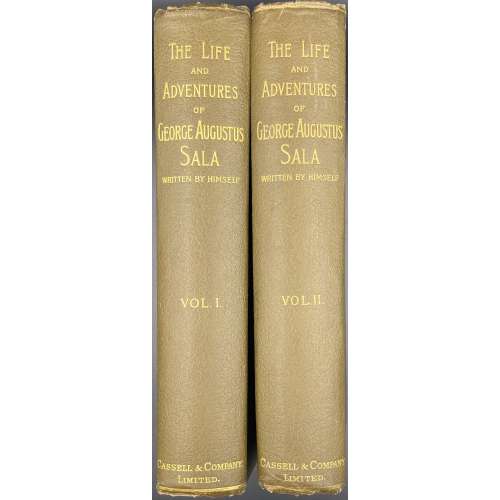 Vol. 1. Title: THE | LIFE AND ADVENTURES | OF | George Augustus Sala | WRITTEN BY HIMSELF | In Two Volumes | VOL. I. | (WITH PORTRAIT OF THE AUTHOR) | CASSEL AND COMPANY, Limited | LONDON, PARIS & MELBOURNE | 1895 | ALL RIGHTS RESERVED || Pagination: frontispiece portrait of Sala by Boussod, Valadon & Cie. w/guard tissue, [i, ii] – t.p./blank, [iii, iv] – dedication/blank, [v]-x – preface, [xi]-xvi – content, [1] 2-442, [16] advert. Collation: A-Z8 AA-BB8 CC5 [Advert.]8. Vol. 2. Title: THE | LIFE AND ADVENTURES | OF | George Augustus Sala | WRITTEN BY HIMSELF | In Two Volumes | VOL. II. | (WITH PORTRAIT OF THE AUTHORS MOTHER) | CASSEL AND COMPANY, Limited | LONDON, PARIS & MELBOURNE | 1895 | ALL RIGHTS RESERVED || Pagination: frontispiece portrait of Sal’s mother w/guard tissue, [i, ii] – t.p. / blank, [iii] iv-viii – content, [1] 2-457-[460], [16] advert. Collation: A-Z8 aa-cc8 dd6 [Advert.]8. Binding: two volumes in uniform green publisher’s pebbled buckram, gilt lettering to spine, contemporary newspaper clippings to front and back pastedowns, vol. 2 uncut. Note: George Augustus Sala's mother was an actress Henrietta Simon Sala, known as Madame Sala, (Guyanese, British, 1789 – 1860). Here she is depicted by an engraver Thomas Alfred Woolnoth (British, 1785 – 1857) after a portrait painted by Rose Emma Drummond (British, fl. 1820 – 1840).
Vol. 1. Title: THE | LIFE AND ADVENTURES | OF | George Augustus Sala | WRITTEN BY HIMSELF | In Two Volumes | VOL. I. | (WITH PORTRAIT OF THE AUTHOR) | CASSEL AND COMPANY, Limited | LONDON, PARIS & MELBOURNE | 1895 | ALL RIGHTS RESERVED || Pagination: frontispiece portrait of Sala by Boussod, Valadon & Cie. w/guard tissue, [i, ii] – t.p./blank, [iii, iv] – dedication/blank, [v]-x – preface, [xi]-xvi – content, [1] 2-442, [16] advert. Collation: A-Z8 AA-BB8 CC5 [Advert.]8. Vol. 2. Title: THE | LIFE AND ADVENTURES | OF | George Augustus Sala | WRITTEN BY HIMSELF | In Two Volumes | VOL. II. | (WITH PORTRAIT OF THE AUTHORS MOTHER) | CASSEL AND COMPANY, Limited | LONDON, PARIS & MELBOURNE | 1895 | ALL RIGHTS RESERVED || Pagination: frontispiece portrait of Sal’s mother w/guard tissue, [i, ii] – t.p. / blank, [iii] iv-viii – content, [1] 2-457-[460], [16] advert. Collation: A-Z8 aa-cc8 dd6 [Advert.]8. Binding: two volumes in uniform green publisher’s pebbled buckram, gilt lettering to spine, contemporary newspaper clippings to front and back pastedowns, vol. 2 uncut. Note: George Augustus Sala's mother was an actress Henrietta Simon Sala, known as Madame Sala, (Guyanese, British, 1789 – 1860). Here she is depicted by an engraver Thomas Alfred Woolnoth (British, 1785 – 1857) after a portrait painted by Rose Emma Drummond (British, fl. 1820 – 1840). -
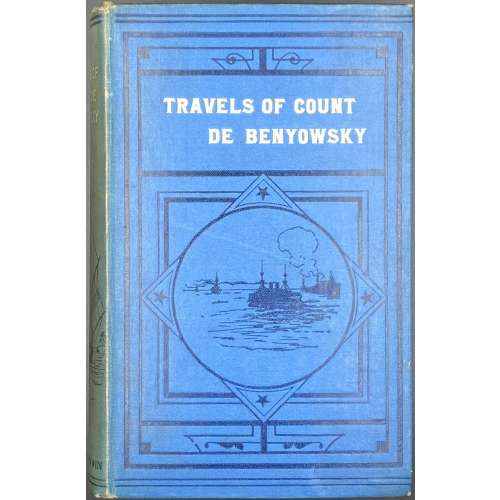 Hardcover volume in 8vo, 20.4 x 13.7 cm, blue cloth with black pictorial stamping and white embossed lettering to front cover and spine, spine sunned, head and tail frayed. Title-page: ❦❦❦ THE MEMOIRS AND | TRAVELS OF MAURITIUS | AUGUSTUS COUNT DE | BENYOWSKY ❦❦❦ | IN SIBERIA, KAMCHATKA, JAPAN, | THE LIUKIU ISLANDS AND FORMOSA | FROM THE TRANSLATION OF HIS | ORIGINAL MANUSCRIPT (1741–1771), | BY WILLIAM NICHOLSON, F.R.S., 1790 | EDITED BY CAPTAIN | PASFIELD OLIVER | ILLUSTRATED | LONDON: T. FISHER UNWIN, | PATERNOSTER SQUARE. MDCCCXCVIII || Collation/Pagination: [1]7 2-258; blue advertisement sheet laid in. [1, 2] – serial h.t. "The Adventure Series" / advert. THE ADVENTURE SERIES. Illustrated. Popular Re-issue, large cr. 8vo, 3s. 6d. 8 titles, [3, 4] – t.p. / blank, [5] 6-9 contents, [10] blank, [11, 12] missing, [13] 14-52 introduction, 53-399, [400] colophon: THE GRESHAM PRESS, | URWIN BROTHERS, | WORKING IN LONDON. Total number of leaves 199; 398 pages; one leaf of the first gathering missing (pp. 11/12 list of illustrations. No illustrations in this volume. Compared to another copy of the same edition, LIB-2701.2021, besides the binding: no list of illustrations, no illustrations, different colophon, different advertisement, slightly different h.t. Contributors: Publisher: T. Fisher Unwin (London); Thomas Fisher Unwin (British, 1848 – 1935). Author: Maurice Auguste count de Benyowsky [Мориц Август Бенёвский] (Polish-Slovak-Hungarian, 1746 –1786). Editor: Samuel Pasfield Oliver (British, 1838 – 1907). Translator: William Nicholson (British, 1753 – 1815). Originally published in 1790, in London (I have not seen it anywhere) and in Dublin by P. Wogan [etc.], and in 1791 in French, in Paris by Buisson; see LIB-2742.2021. For the 1904 edition, see LIB-2703.2021.
Hardcover volume in 8vo, 20.4 x 13.7 cm, blue cloth with black pictorial stamping and white embossed lettering to front cover and spine, spine sunned, head and tail frayed. Title-page: ❦❦❦ THE MEMOIRS AND | TRAVELS OF MAURITIUS | AUGUSTUS COUNT DE | BENYOWSKY ❦❦❦ | IN SIBERIA, KAMCHATKA, JAPAN, | THE LIUKIU ISLANDS AND FORMOSA | FROM THE TRANSLATION OF HIS | ORIGINAL MANUSCRIPT (1741–1771), | BY WILLIAM NICHOLSON, F.R.S., 1790 | EDITED BY CAPTAIN | PASFIELD OLIVER | ILLUSTRATED | LONDON: T. FISHER UNWIN, | PATERNOSTER SQUARE. MDCCCXCVIII || Collation/Pagination: [1]7 2-258; blue advertisement sheet laid in. [1, 2] – serial h.t. "The Adventure Series" / advert. THE ADVENTURE SERIES. Illustrated. Popular Re-issue, large cr. 8vo, 3s. 6d. 8 titles, [3, 4] – t.p. / blank, [5] 6-9 contents, [10] blank, [11, 12] missing, [13] 14-52 introduction, 53-399, [400] colophon: THE GRESHAM PRESS, | URWIN BROTHERS, | WORKING IN LONDON. Total number of leaves 199; 398 pages; one leaf of the first gathering missing (pp. 11/12 list of illustrations. No illustrations in this volume. Compared to another copy of the same edition, LIB-2701.2021, besides the binding: no list of illustrations, no illustrations, different colophon, different advertisement, slightly different h.t. Contributors: Publisher: T. Fisher Unwin (London); Thomas Fisher Unwin (British, 1848 – 1935). Author: Maurice Auguste count de Benyowsky [Мориц Август Бенёвский] (Polish-Slovak-Hungarian, 1746 –1786). Editor: Samuel Pasfield Oliver (British, 1838 – 1907). Translator: William Nicholson (British, 1753 – 1815). Originally published in 1790, in London (I have not seen it anywhere) and in Dublin by P. Wogan [etc.], and in 1791 in French, in Paris by Buisson; see LIB-2742.2021. For the 1904 edition, see LIB-2703.2021. -
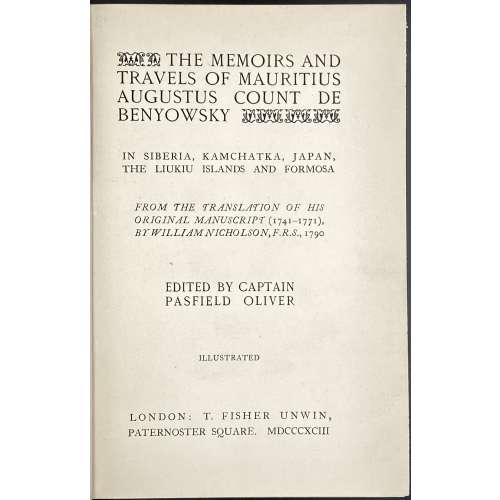 Hardcover volume in 8vo, 21.2 x 15.4 cm, tan cloth with black on gilt background circular publisher’s device "TFU" to front cover, gilt-stamped compartments and burgundy labels with gilt lettering to spine. Ink inscription to fep verso dated Jan 18, 1907. Publisher's device and serial device to h.t. Title-page: ❦❦❦ THE MEMOIRS AND | TRAVELS OF MAURITIUS AUGUSTUS COUNT DE | BENYOWSKY | IN SIBERIA, KAMCHATKA, JAPAN, THE LIUKIU ISLANDS AND FORMOSA | FROM THE TRANSLATION OF HIS | ORIGINAL MANUSCRIPT (1741–1771), | BY WILLIAM NICHOLSON, F.R.S., 1790 | EDITED BY CAPTAIN | PASFIELD OLIVER | ILLUSTRATED | LONDON: T. FISHER UNWIN, | PATERNOSTER SQUARE. MDCCCXCIII ❦❦❦ ||. Collation/Pagination: [1]-258 plus 7 plates, incl. frontispiece and 1 map. [1, 2] – serial h.t. "The Adventure Series" / advert. THE ADVENTURE SERIES. Illustrated. Crown 8vo, 5s. 17 titles, [3, 4] – t.p. / blank, [5] 6-9 contents, [10] blank, [11, 12] illustrations/blank, [13] 14-52 introduction, 53-399, [400] colophon: THE GRESHAM PRESS, | URWIN BROTHERS, | CHILWORTH AND LONDON. Contributors: Publisher: T. Fisher Unwin (London); Thomas Fisher Unwin (British, 1848 – 1935). Author: Maurice Auguste count de Benyowsky [Мориц Август Бенёвский] (Polish-Slovak-Hungarian, 1746 –1786). Editor: Samuel Pasfield Oliver (British, 1838 – 1907). Translator: William Nicholson (British, 1753 – 1815). Originally published in 1790, in London (I have not seen it anywhere) and in Dublin by P. Wogan [etc.], and in 1791 in French, in Paris by Buisson; see LIB-2742.2021. For another copy of the same edition, see LIB-3139.2023. For the 1904 edition, see LIB-2703.2021.
Hardcover volume in 8vo, 21.2 x 15.4 cm, tan cloth with black on gilt background circular publisher’s device "TFU" to front cover, gilt-stamped compartments and burgundy labels with gilt lettering to spine. Ink inscription to fep verso dated Jan 18, 1907. Publisher's device and serial device to h.t. Title-page: ❦❦❦ THE MEMOIRS AND | TRAVELS OF MAURITIUS AUGUSTUS COUNT DE | BENYOWSKY | IN SIBERIA, KAMCHATKA, JAPAN, THE LIUKIU ISLANDS AND FORMOSA | FROM THE TRANSLATION OF HIS | ORIGINAL MANUSCRIPT (1741–1771), | BY WILLIAM NICHOLSON, F.R.S., 1790 | EDITED BY CAPTAIN | PASFIELD OLIVER | ILLUSTRATED | LONDON: T. FISHER UNWIN, | PATERNOSTER SQUARE. MDCCCXCIII ❦❦❦ ||. Collation/Pagination: [1]-258 plus 7 plates, incl. frontispiece and 1 map. [1, 2] – serial h.t. "The Adventure Series" / advert. THE ADVENTURE SERIES. Illustrated. Crown 8vo, 5s. 17 titles, [3, 4] – t.p. / blank, [5] 6-9 contents, [10] blank, [11, 12] illustrations/blank, [13] 14-52 introduction, 53-399, [400] colophon: THE GRESHAM PRESS, | URWIN BROTHERS, | CHILWORTH AND LONDON. Contributors: Publisher: T. Fisher Unwin (London); Thomas Fisher Unwin (British, 1848 – 1935). Author: Maurice Auguste count de Benyowsky [Мориц Август Бенёвский] (Polish-Slovak-Hungarian, 1746 –1786). Editor: Samuel Pasfield Oliver (British, 1838 – 1907). Translator: William Nicholson (British, 1753 – 1815). Originally published in 1790, in London (I have not seen it anywhere) and in Dublin by P. Wogan [etc.], and in 1791 in French, in Paris by Buisson; see LIB-2742.2021. For another copy of the same edition, see LIB-3139.2023. For the 1904 edition, see LIB-2703.2021. -
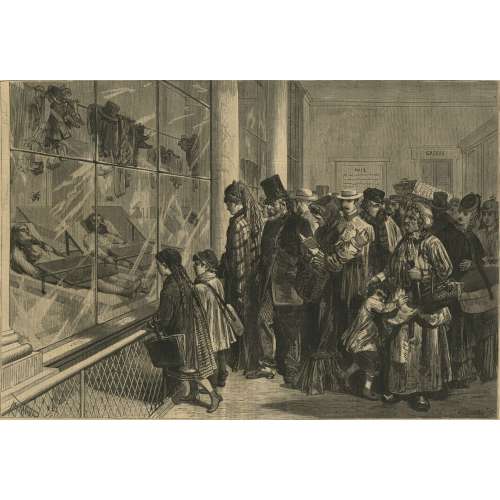
-
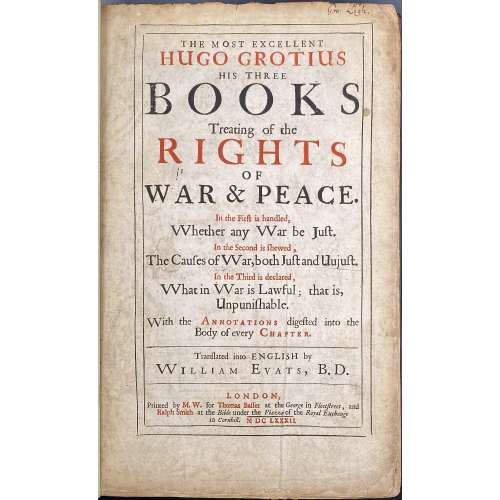 Volume collated 4to, 32.5 x 21 cm, later full calf, blind-tooled boards, sunned, raised bands and gilt lettering to spine. bound without the additional engraved title-page sometimes present; title printed in black and red, woodcut headpieces and initials; a little foxing (mostly marginal) throughout, title lightly dust stained with slight chipping at extremities, minor marginal worming to early leaves (b3-I4), paper flaw to outer margin of E1; contemporary English ownership inscription of George Legh to the title, a handful of manuscript corrections to text and annotations to index. Title-page (double frame, red and black, tall ‘s’): THE MOST EXCELLENT | HUGO GROTIUS | HIS THREE | BOOKS | Treating of the | RIGHTS | OF | WAR & PEACE. | In the First is handled, | Whether any War be Just. | In the Second is shewed , | The Causes of War, both Just and Uujust (sic). | In the Third is declared , | What in War is Lawful ; that is, | Unpunishable. | With the Annotations digested into the | Body of every Chapter. | — | Translated into ENGLISH by | William Evats, B. D. | — | LONDON, | Printed by M. W. for Thomas Basset at the George in Fleetstreet, and | Ralph Smith at the Bible under the Piazza of the Royal Exchange | in Cornhill. M DC LXXXII. || Collation: A4 a-b4 c3 B-Z4 2A-2D4 2E6 3A-3Z4 4A-4D4 4E-4L2; total 247 leaves as called for; lacking engraved title-page. Pagination: [4] i-xxi [5] 1-220 (text continuous) 361-572 [573] [574 blank] [30 table]; total 494 pages. Seller’s note: First edition of the first complete English translation, following Barksdale’s abridgement, of Grotius’s landmark work of political philosophy, the first treatise on international law. First published in Latin in 1625, Grotius’s De iure belli ac pacis “became the basic manual for both the theoretical justification and the entire practice of the international law of war as well as of international law in general for the whole period of the ancien régime in Europe” [Duchhardt, p. 288]. “It would be hard to imagine any work more central to the intellectual world of the Enlightenment … [By] the time of the post-First World War settlement, Grotius was regarded almost exclusively as the founder of modern civilized interstate relations, and as a suitable tutelary presence for the new Peace Palace at The Hague … [In] some ways that was to radically misunderstand Grotius’s views on war; he was in fact much more of an apologist for aggression and violence than many of his more genuinely innovative qualities of his moral theory, qualities that entitle him to an essential place in the history of political theory …” [Tuck, pp. xi-xii]. Contributors: Hugo Grotius (Dutch, 1583 – 1645) – author. William Evats (British, c.1606 – 1677) – translator. Margaret White (British, fl. 1678 – 1683) – printer. Thomas Bassett (British, fl. c. 1659 – 1693) – publisher/bookseller. Ralph Smith (British, fl. 1642 – 1684) – publisher/bookseller.
Volume collated 4to, 32.5 x 21 cm, later full calf, blind-tooled boards, sunned, raised bands and gilt lettering to spine. bound without the additional engraved title-page sometimes present; title printed in black and red, woodcut headpieces and initials; a little foxing (mostly marginal) throughout, title lightly dust stained with slight chipping at extremities, minor marginal worming to early leaves (b3-I4), paper flaw to outer margin of E1; contemporary English ownership inscription of George Legh to the title, a handful of manuscript corrections to text and annotations to index. Title-page (double frame, red and black, tall ‘s’): THE MOST EXCELLENT | HUGO GROTIUS | HIS THREE | BOOKS | Treating of the | RIGHTS | OF | WAR & PEACE. | In the First is handled, | Whether any War be Just. | In the Second is shewed , | The Causes of War, both Just and Uujust (sic). | In the Third is declared , | What in War is Lawful ; that is, | Unpunishable. | With the Annotations digested into the | Body of every Chapter. | — | Translated into ENGLISH by | William Evats, B. D. | — | LONDON, | Printed by M. W. for Thomas Basset at the George in Fleetstreet, and | Ralph Smith at the Bible under the Piazza of the Royal Exchange | in Cornhill. M DC LXXXII. || Collation: A4 a-b4 c3 B-Z4 2A-2D4 2E6 3A-3Z4 4A-4D4 4E-4L2; total 247 leaves as called for; lacking engraved title-page. Pagination: [4] i-xxi [5] 1-220 (text continuous) 361-572 [573] [574 blank] [30 table]; total 494 pages. Seller’s note: First edition of the first complete English translation, following Barksdale’s abridgement, of Grotius’s landmark work of political philosophy, the first treatise on international law. First published in Latin in 1625, Grotius’s De iure belli ac pacis “became the basic manual for both the theoretical justification and the entire practice of the international law of war as well as of international law in general for the whole period of the ancien régime in Europe” [Duchhardt, p. 288]. “It would be hard to imagine any work more central to the intellectual world of the Enlightenment … [By] the time of the post-First World War settlement, Grotius was regarded almost exclusively as the founder of modern civilized interstate relations, and as a suitable tutelary presence for the new Peace Palace at The Hague … [In] some ways that was to radically misunderstand Grotius’s views on war; he was in fact much more of an apologist for aggression and violence than many of his more genuinely innovative qualities of his moral theory, qualities that entitle him to an essential place in the history of political theory …” [Tuck, pp. xi-xii]. Contributors: Hugo Grotius (Dutch, 1583 – 1645) – author. William Evats (British, c.1606 – 1677) – translator. Margaret White (British, fl. 1678 – 1683) – printer. Thomas Bassett (British, fl. c. 1659 – 1693) – publisher/bookseller. Ralph Smith (British, fl. 1642 – 1684) – publisher/bookseller. -
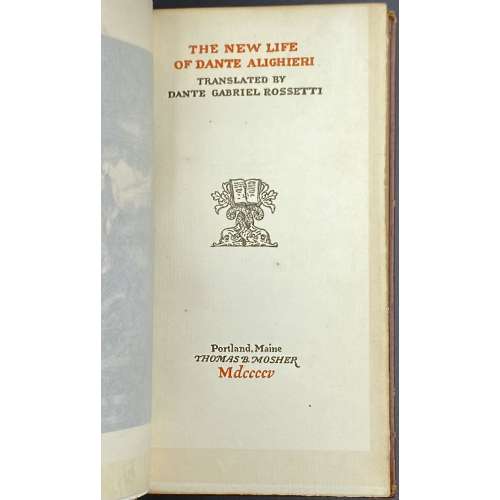 Title: THE NEW LIFE | OF DANTE ALIGHIERI | TRANSLATED BY | DANTE GABRIEL ROSSETTI | {Publisher's device} | Portland, Maine | THOMAS B. MOSHER | Mdccccv Pagination: Ffl [i-viii] ix-xii [xiii] [xiv blank], [1, 2] 3-97 [98] bfl; frontis. w/guard; Note: “This fourth edition on Van Gelder paper consists of 925 copies”. Binding: Hardcover, 18.2 x 10.2 cm, full brown morocco possibly by Sangorski & Sutcliffe, with embossed design elements, raised bands, gilt lettering to spine, TMG, other untrimmed; printed on laid paper with watermark.
Title: THE NEW LIFE | OF DANTE ALIGHIERI | TRANSLATED BY | DANTE GABRIEL ROSSETTI | {Publisher's device} | Portland, Maine | THOMAS B. MOSHER | Mdccccv Pagination: Ffl [i-viii] ix-xii [xiii] [xiv blank], [1, 2] 3-97 [98] bfl; frontis. w/guard; Note: “This fourth edition on Van Gelder paper consists of 925 copies”. Binding: Hardcover, 18.2 x 10.2 cm, full brown morocco possibly by Sangorski & Sutcliffe, with embossed design elements, raised bands, gilt lettering to spine, TMG, other untrimmed; printed on laid paper with watermark.



